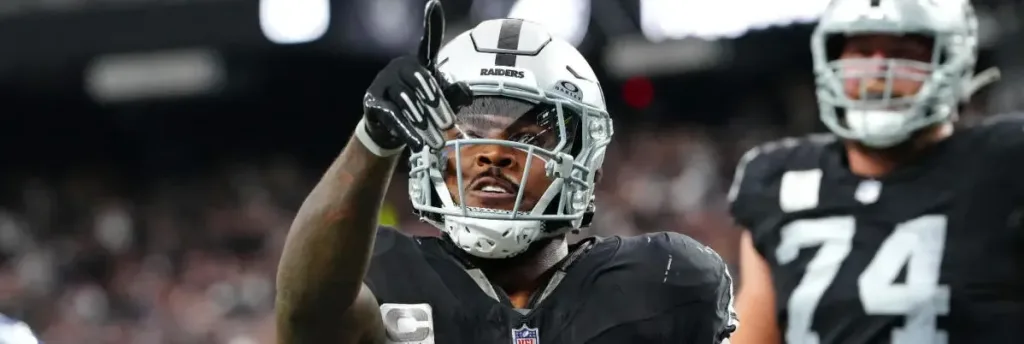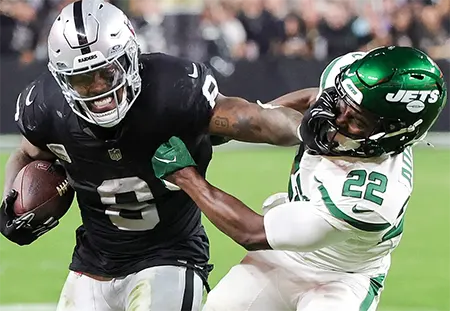Mastering the Game: Packers’ Bold Decision in NFL Free Agency 2024 – Josh Jacobs In, Aaron Jones Out – The Ultimate Strategy Revealed!

Brief overview of the Packers’ bold decision for Josh Jacobs.
The Packers’ bold decision in the NFL Free Agency 2024 has sent shockwaves through the football community. With the stakes high and anticipation building, the team’s front office orchestrated a strategic move that caught both fans and pundits by surprise. This decision is not merely a transaction but a pivotal moment that will shape the Packers’ future and redefine their approach in the upcoming seasons.
In this bold move, the Packers have ushered in a new era with the acquisition of Josh Jacobs. The dynamic running back brings a fresh set of skills and accomplishments, promising to inject vitality into the team’s offensive strategy. The departure of Aaron Jones, while undoubtedly a tough call, is indicative of the Packers’ commitment to adaptability and strategic planning. This shift reflects a calculated move aimed at fortifying the team’s competitive edge and ensuring sustained success in the dynamic landscape of the NFL.
As we delve into the nuances of this decision, it becomes clear that the Packers are not merely making choices based on short-term gains. Instead, there is a comprehensive strategy at play, one that considers the team’s historical context, the current state of the league, and the unique strengths that Josh Jacobs brings to the table. This bold decision is a testament to the Packers’ commitment to excellence and their unwavering pursuit of success in the ever-evolving world of professional football.
Why did the Packers decide to part ways with Aaron Jones?
The decision to part ways with the seasoned running back, Aaron Jones, was a strategic move by the Green Bay Packers, influenced by a combination of factors that stretched beyond the football field. At 29 years old, Jones, while having contributed significantly to the team’s success in the past, faced the inevitable challenge of age affecting his on-field performance.
The Packers, known for their forward-thinking approach, recognized the importance of planning for the future and making decisions that align with the team’s long-term goals.

Health emerged as a critical consideration in this decision-making process. As athletes age, the wear and tear on their bodies become more pronounced, impacting their ability to maintain peak performance. The Packers, in evaluating Jones’ health profile, faced the reality that his sustained effectiveness could face challenges in the coming years.
This foresight prompted the organization to explore alternative options that could offer a more sustainable and robust contribution to the team’s offensive capabilities.
Financial considerations further underscored the complexity of this decision. Aaron Jones’ estimated $30 million contract presented a significant financial commitment, and with the need to balance the team’s budget effectively, the Packers had to weigh the long-term value against immediate financial constraints.
The decision to part ways with Jones resulted in a $12.4 million dead money hit for the current year, but the team achieved a $5.22 million savings by opting for this move. These financial intricacies reflect the delicate balance that NFL teams, including the Packers, must strike to maintain competitiveness while managing budgetary constraints.
In contrast, the allure of Josh Jacobs as a replacement for Jones became evident, not only due to his on-field prowess but also because of his favorable health profile. Jacobs represented a younger, dynamic option that aligned more closely with the Packers’ vision for the future. The decision to bring in Jacobs was not just a reactive move but a proactive step towards ensuring the team’s sustained success, taking into account both performance and financial considerations in a complex NFL landscape.
What are some other players that the Packers signed?
The Green Bay Packers didn’t stop at the bold acquisition of Josh Jacobs during the 2024 free agency; they strategically bolstered their roster with a mix of seasoned players and promising talents. At the forefront is the Pro Bowl running back, Jacobs, whose four-year, $48 million contract signifies the team’s commitment to building a formidable ground game.
Jacobs brings a unique blend of strength, explosiveness, and versatility, injecting a new dimension into the Packers’ offensive arsenal. The move not only addresses immediate needs but also lays the groundwork for a dynamic and diversified ground attack.
In addition to Jacobs, the Packers secured the talents of Xavier McKinney, a former player for the New York Giants. The safety inked a four-year, $68 million contract, emphasizing the team’s dedication to fortifying its defensive capabilities.

McKinney’s adaptability as a blocker and receiver adds depth to the tight end position, offering the Packers a multifaceted player who can contribute across various facets of the game. The strategic move reflects a comprehensive approach to building a well-rounded and resilient team for the challenges ahead.
Returning to Green Bay, Jon Runyan Jr. brings a wealth of experience and versatility along the offensive line. The significance of Runyan’s presence lies not only in his ability to provide depth but also in his familiarity with the Packers’ system. This ensures continuity and stability, vital components in sustaining success in the NFL.
Moreover, the Packers addressed the cornerback position with the departure of Darnell Savage by adding Keisean Nixon, providing valuable depth to the group of cornerbacks. The strategic recruitment of players like Nixon showcases the team’s commitment to maintaining a competitive and resilient defensive lineup.
While the Packers made bold moves in the free agency, they also ensured the continuity of their backfield by retaining A.J. Dillon. Dillon’s role remains pivotal, serving as a complement to the dynamic presence of Josh Jacobs. This strategic combination of seasoned veterans and emerging talents illustrates the Packers’ commitment to a balanced and formidable roster, setting the stage for an exciting and competitive NFL season ahead.
What prompted the Packers to make strategic changes?
The strategic changes undertaken by the Green Bay Packers for the 2018 NFL season were prompted by a combination of factors aimed at optimizing the team’s performance and addressing specific challenges. The departure of veteran left tackle David Bakhtiari, primarily due to lingering knee issues that limited his playing time, necessitated a crucial reevaluation of the team’s offensive line. Bakhtiari’s absence created a void that required a trustworthy replacement, prompting the Packers to make calculated adjustments to maintain the integrity of their offensive unit.
One of the key moves in response to this situation was the addition of running back Josh Jacobs. This decision aligns with the vision set forth by general manager Brian Gutekunst, who sought to infuse the lineup with seasoned players possessing versatility and experience. Jacobs emerged as a fitting candidate, not only for his prowess in the backfield but also for his ability to contribute in various capacities.
The release of the talented running back Aaron Jones played a pivotal role in creating the necessary cap space, allowing the Packers to strategically invest in areas that would reinforce the team’s competitiveness. These tactical adjustments underscore the Packers’ commitment to crafting a competitive and future-focused squad, showcasing a strategic alignment between their objectives and the dynamic landscape of the NFL.
How does the salary cap work in the NFL?
Understanding the intricacies of the NFL salary cap is crucial for teams aiming to navigate the league’s financial landscape effectively. The salary cap serves as a foundational element for maintaining financial parity and fair competition among teams. For the 2023 season, the cap was set at $224.8 million, acting as a ceiling on the total amount teams can allocate to player salaries.
This cap is determined by a combination of revenue streams, including local sources, NFL ventures and playoffs, and media deals. The cap’s purpose is to prevent wealthier teams from significantly outspending their counterparts, ensuring a level playing field and fostering competitive balance across the league.
Teams operate within the constraints of the salary cap, and exceeding it is strictly prohibited. At the start of each new league year, all clubs must be below the cap, creating a standardized framework for financial management. However, savvy teams often employ strategic maneuvers to optimize their roster within these limitations.
Techniques like signing incentives and contract reorganization can be utilized to maneuver around the cap, allowing teams to make strategic financial decisions while adhering to the established rules. Successfully managing player contracts, bonuses, and cap restrictions becomes a critical aspect of team building, requiring a delicate balance between financial efficiency and assembling competitive rosters.
In essence, the salary cap system is not just a financial constraint but a dynamic element that adds complexity to the strategic planning of NFL teams. Navigating this system requires a keen understanding of the rules, creative financial management, and a strategic vision to build a winning team while adhering to the league’s financial regulations. The delicate dance between financial constraints and the pursuit of victory shapes the landscape of the NFL, making effective salary cap management a hallmark of successful franchise operations.
What factors were considered in selecting Josh Jacobs over other options?
The decision to select Josh Jacobs as the Green Bay Packers’ running back for the 2024 season involved a careful consideration of several key factors. Jacobs, renowned for his outstanding performance, particularly in leading the team in rushing yards and contributing significantly in the passing game with 53 catches for 400 yards, emerged as one of the NFL’s top running backs. His versatility and impact on the offense made him an attractive choice for the Packers as they sought to fortify their backfield.
One critical factor in favor of Jacobs was his age. At 26, he represents a younger option compared to Aaron Jones, who was released by the Packers. This age difference aligns with the Packers’ strategic vision to address the running back position with a focus on the long term. Jacobs’ youthfulness not only signifies potential for sustained high performance but also offers the team the opportunity to build a long-lasting and dynamic offensive core. Additionally, the financial aspect came into play, with Jacobs’ contract likely carrying a lower cap hit compared to other options, contributing to the Packers’ overall financial strategy.
A noteworthy aspect of the Packers’ decision-making process is their intention to create a dynamic and versatile backfield by teaming up Jacobs and Aaron Jones. By combining the strengths of both running backs, the Packers aim to keep them fresh throughout the season, ensuring a well-balanced and potent running game. This strategic approach underscores the Packers’ commitment to maximizing the strengths of their roster while addressing both immediate and future needs, positioning them for success in the competitive landscape of the NFL.
When is the expected timeline for observing the strategy in action?
As anticipation builds for the upcoming 2024 NFL season, the Green Bay Packers are eagerly preparing their offensive staff, placing great expectations on the dynamic capabilities of Josh Jacobs. As a key component of the team’s rebuilt roster, Jacobs’s role will be prominently showcased during preseason games, providing fans and analysts a firsthand look at his versatility and on-field performance.
Head coach Matt LaFleur expresses unwavering faith in the offensive group, emphasizing the pivotal role that youthful talent, exemplified by Jacobs, plays in the team’s overall strategy for securing victories in the upcoming season.
Josh Jacobs is not merely a player but a cornerstone of the Packers’ vision for success. LaFleur’s confidence in the offensive lineup, particularly highlighting Jacobs’s contribution, underscores the team’s commitment to leveraging youthfulness as a strategic advantage. With a promising roster featuring five picks in the top 100 and the 25th overall pick in the 2024 draft, the Packers are poised to infuse fresh talent into their lineup.
Despite the heartbreak of the previous season’s loss to the San Francisco 49ers in the NFL Divisional Round, the players and coaching staff are channeling their resolve and determination toward a new beginning in 2024, where Josh Jacobs is expected to play a pivotal role in shaping the team’s offensive dynamics.
As the Packers gear up for preseason games, the spotlight on Josh Jacobs becomes integral to the team’s narrative. His performance will not only be a testament to the offseason rebuilding efforts but also a glimpse into the strategic approach that the Packers are adopting.
The upcoming season is not just a continuation but a fresh start, with Jacobs embodying the youth, energy, and talent that the team believes will be instrumental in achieving success on the field. The timeline for observing this strategy in action is imminent, creating a sense of excitement and anticipation among fans as they eagerly await the unveiling of the Packers’ rejuvenated and dynamic offensive game plan, led by none other than the versatile Josh Jacobs.
Where has Aaron Jones landed, and what is his new role?
Former Green Bay Packers running back, Aaron Jones, has now joined the Dallas Cowboys, marking a significant move after his seven-season tenure with the Packers. Upon becoming a free agent, Jones swiftly found a new home with the Cowboys, who wasted no time securing his services. Let’s delve into the specifics of this transition.
-
Aaron Jones’ Departure from Green Bay:
- Released by the Packers due to failed contract negotiations.
- Jones was set to earn $12 million for the 2024 season.
- The decision was challenging for the Packers’ management.
-
Aaron Jones’ Accomplishments with the Packers:
- Drafted in the fifth round of the 2017 NFL Draft by the Packers.
- Named to the Pro Bowl in 2020; co-led the league in rushing touchdowns in 2019.
- Impressive career stats include 5,940 rushing yards (third-most in team history), 45 rushing touchdowns (fourth in franchise history), and 272 receptions (19th in team history).
-
Josh Jacobs’ Arrival in Green Bay:
- Packers signed Josh Jacobs to a four-year, $48 million deal.
- Jacobs brings versatility and productivity to the Packers’ backfield.
- His addition aligns with the team’s strategy of integrating experienced players with young talent.
-
Comparisons and Implications:
- Jacobs’ arrival raises questions about the future of fellow running back A.J. Dillon, who is also a free agent.
- If Dillon signs elsewhere, Jacobs may inherit a significant share of the Packers’ carries.
- Shifts in the Packers’ backfield dynamics create anticipation among fans to see how both Jacobs and Jones perform in their new roles.
In Dallas, Aaron Jones aims to contribute to the Cowboys’ offensive firepower alongside star quarterback Dak Prescott. Meanwhile, the Packers move forward with a fresh strategy, combining youth and experience to contend in the upcoming season. The team’s decision to release Jones and bring in Jacobs reflects a dynamic approach to roster management, emphasizing both past accomplishments and future potential.
Conclusion:
In conclusion, the dynamic landscape of the NFL’s free agency period has brought about significant changes, particularly in the Green Bay Packers’ running back scenario. The departure of Aaron Jones, a stalwart in the Packers’ backfield for seven seasons, marks a poignant moment in the team’s history. However, the strategic move to bring in Josh Jacobs, a dynamic and versatile running back, signals a bold step towards reshaping the team’s offensive dynamics.
As we explore the intricacies of the Packers’ decision-making process, it becomes evident that both short-term and long-term considerations played pivotal roles. The financial implications of player contracts, the team’s commitment to building a competitive and balanced roster, and the integration of youth with experience are all critical aspects that shaped these strategic moves.
Looking ahead to the 2024 NFL season, the Packers and their fans eagerly anticipate witnessing the new running back strategy in action. The combination of Josh Jacobs and the potential role changes within the Packers’ backfield adds an element of excitement and uncertainty, creating a narrative that will unfold on the field.
In the broader context of the NFL, where every move is scrutinized, the Packers’ approach to roster management and strategic player acquisitions exemplifies the constant evolution required to stay competitive. As fans prepare for the upcoming season, the storyline of Aaron Jones in Dallas and Josh Jacobs in Green Bay adds layers of intrigue to an already compelling narrative.
Ultimately, the Packers’ decisions reflect a commitment to balance, adaptability, and a vision for sustained success. The NFL’s ever-shifting landscape ensures that each season brings new challenges and opportunities, and the Packers’ moves in the free agency market underscore their determination to master the game and navigate the complexities of professional football. As the season unfolds, fans will witness whether these strategic decisions translate into on-field success for the Green Bay Packers.
FAQs:
Q: Why did the Green Bay Packers release Aaron Jones?
Answer: The Packers released Aaron Jones due to failed contract negotiations, financial considerations, and a strategic vision to address the running back position for long-term success.
Q: What factors influenced the selection of Josh Jacobs as the new running back for the Packers?
Answer: The decision to sign Josh Jacobs was influenced by his versatility, productivity, and the team’s strategic approach of integrating experienced players with young talent to reshape the offensive dynamics.
Q: How does the NFL salary cap impact roster decisions, specifically in the case of Aaron Jones and Josh Jacobs?
Answer: The NFL salary cap serves as a crucial factor in roster decisions, influencing the release of players like Aaron Jones and the strategic signing of players like Josh Jacobs. Teams must navigate financial constraints while building competitive rosters.
Q: What changes can fans expect in the Packers’ backfield dynamics for the 2024 NFL season?
Answer: With the departure of Aaron Jones and the addition of Josh Jacobs, fans can anticipate shifts in the Packers’ backfield dynamics. The combination of Jacobs and potential role changes within the running back unit adds excitement and uncertainty to the upcoming season.
Q: How do the Packers’ strategic moves align with the broader trends in the NFL’s free agency market?
Answer: The Packers’ strategic moves exemplify the constant evolution required to stay competitive in the NFL. By balancing financial considerations, roster management, and a vision for sustained success, the team navigates the complexities of professional football, reflecting broader trends in the league’s dynamic landscape.













